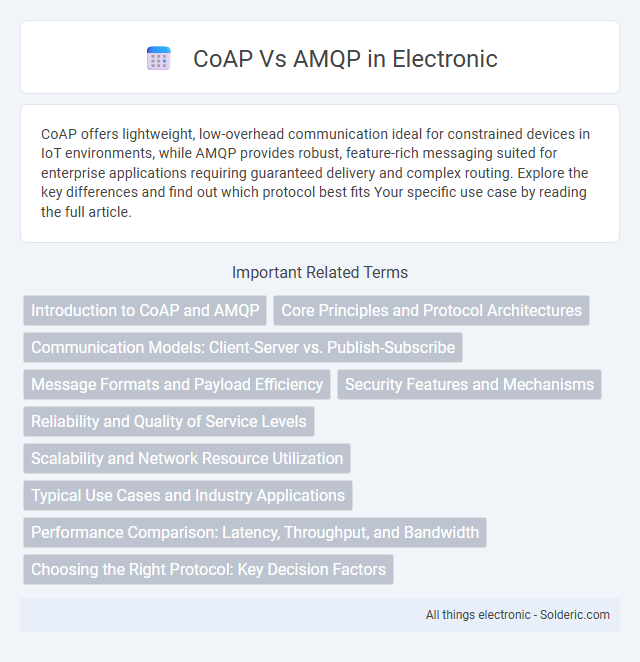CoAP offers lightweight, low-overhead communication ideal for constrained devices in IoT environments, while AMQP provides robust, feature-rich messaging suited for enterprise applications requiring guaranteed delivery and complex routing. Explore the key differences and find out which protocol best fits Your specific use case by reading the full article.
Comparison Table
| Feature | CoAP (Constrained Application Protocol) | AMQP (Advanced Message Queuing Protocol) |
|---|---|---|
| Protocol Type | RESTful, Application Layer | Message-Oriented Middleware |
| Primary Use Case | IoT devices, constrained networks | Enterprise messaging, reliable queuing |
| Transport Protocol | UDP | TCP |
| Communication Pattern | Request/Response | Publish/Subscribe, Queuing |
| Message Size | Small, optimized for low overhead | Supports large and complex messages |
| Reliability | Confirmable messages with retransmission | Guaranteed delivery, acknowledgments |
| Security | DTLS (Datagram Transport Layer Security) | TLS, SASL, Encryption, Authentication |
| Quality of Service (QoS) | At most once, at least once | Exactly once, at least once, at most once |
| Use in Resource Constraints | Designed specifically for constrained devices | Requires more resources, suited for robust systems |
| Standardization | IETF RFC 7252 | OASIS Standard |
Introduction to CoAP and AMQP
CoAP (Constrained Application Protocol) is a lightweight protocol designed for resource-constrained devices in IoT environments, enabling efficient RESTful communication over UDP. AMQP (Advanced Message Queuing Protocol) is a robust messaging protocol that supports reliable, secure, and interoperable message exchange in distributed systems using TCP. Understanding the distinct purposes and architectures of CoAP and AMQP helps you select the right protocol based on your application's scalability and resource constraints.
Core Principles and Protocol Architectures
CoAP (Constrained Application Protocol) is designed for resource-constrained IoT devices, emphasizing lightweight, RESTful interactions over UDP with a request/response model optimized for low bandwidth and minimal power consumption. AMQP (Advanced Message Queuing Protocol) focuses on reliable, secure message-oriented middleware with complex routing capabilities, using a broker-based architecture over TCP to ensure guaranteed message delivery, transactionality, and flexible message patterns. The fundamental difference lies in CoAP's simplicity and efficiency for constrained environments versus AMQP's robustness and feature-rich design for enterprise-grade messaging systems.
Communication Models: Client-Server vs. Publish-Subscribe
CoAP (Constrained Application Protocol) primarily utilizes a client-server communication model optimized for lightweight, request-response interactions in constrained IoT environments. In contrast, AMQP (Advanced Message Queuing Protocol) is built around a publish-subscribe model that supports asynchronous messaging and reliable event distribution in complex, distributed systems. The client-server model in CoAP enables direct device communication, while AMQP's publish-subscribe architecture facilitates decoupled communication ideal for scalable and flexible message exchange.
Message Formats and Payload Efficiency
CoAP (Constrained Application Protocol) utilizes a lightweight binary message format designed for minimal overhead, making it highly efficient for small payloads in constrained IoT environments. AMQP (Advanced Message Queuing Protocol) employs a more complex, extensible format that supports rich messaging features but typically incurs higher payload overhead, suitable for enterprise-level applications requiring reliable messaging. Your choice between CoAP and AMQP should consider the balance between payload efficiency and the need for advanced messaging capabilities.
Security Features and Mechanisms
CoAP (Constrained Application Protocol) employs Datagram Transport Layer Security (DTLS) to provide encryption, integrity, and authentication tailored for resource-constrained IoT devices, ensuring secure communication in low-power, lossy networks. AMQP (Advanced Message Queuing Protocol) supports Transport Layer Security (TLS) and Simple Authentication and Security Layer (SASL) frameworks, offering robust end-to-end security features including message encryption, authentication, and authorization for enterprise-grade messaging systems. Both protocols implement mechanisms to counteract replay attacks and ensure message confidentiality, but AMQP generally provides more comprehensive security capabilities suitable for complex, high-throughput environments.
Reliability and Quality of Service Levels
CoAP supports confirmable and non-confirmable message types to ensure basic reliability, offering simple Quality of Service (QoS) with optional acknowledgments and retransmissions suited for constrained networks. AMQP provides advanced reliability features, including exactly-once delivery and message acknowledgments, ensuring robust QoS through persistent messaging and transactional support. The choice between CoAP and AMQP depends on application requirements for reliability, where CoAP fits lightweight IoT devices and AMQP suits enterprise-level messaging with stringent QoS demands.
Scalability and Network Resource Utilization
CoAP (Constrained Application Protocol) excels in scalability within low-power and lossy networks due to its lightweight design and UDP-based communication, minimizing bandwidth and energy consumption. AMQP (Advanced Message Queuing Protocol) offers robust scalability for complex, high-throughput enterprise environments with guaranteed message delivery but consumes more network resources because of its TCP overhead and richer feature set. Efficient network resource utilization in IoT applications favors CoAP, while AMQP suits scalable infrastructures demanding reliable messaging and advanced flow control.
Typical Use Cases and Industry Applications
CoAP excels in constrained environments such as smart home devices, IoT sensors, and low-power networks where lightweight communication and minimal overhead are critical. AMQP is widely used in enterprise messaging systems, financial transactions, and reliable queue management, supporting complex routing and guaranteed message delivery. Your choice depends on whether you prioritize low resource consumption for IoT scenarios or robust, secure message brokering in industrial and cloud applications.
Performance Comparison: Latency, Throughput, and Bandwidth
CoAP offers lower latency and reduced bandwidth consumption due to its lightweight UDP protocol, making it ideal for constrained IoT environments. AMQP provides higher throughput and reliable message delivery by utilizing TCP, which ensures ordered communication but introduces latency overhead. Your choice depends on whether minimizing latency and bandwidth (favoring CoAP) or maximizing throughput with guaranteed delivery (favoring AMQP) aligns better with your application's performance requirements.
Choosing the Right Protocol: Key Decision Factors
Choosing between CoAP and AMQP depends largely on the application's communication needs and resource constraints. CoAP is optimized for low-power, low-bandwidth IoT devices, offering lightweight UDP-based messaging suitable for constrained environments. AMQP provides robust, reliable, and secure message queuing over TCP, making it ideal for enterprise-level applications requiring complex routing and guaranteed delivery.
CoAP vs AMQP Infographic

 solderic.com
solderic.com